
views
Gathering and Cleaning the Seeds

Remove the seeds from an orange. Slice an orange in half to reveal the seeds. Use a spoon or knife to pick out the seeds. The tree that grows will likely produce similar fruit, so make sure you choose the seeds of an orange variety you like. Some orange varieties, such as navels and clementines, are seedless, and you won’t be able to propagate orange trees this way.
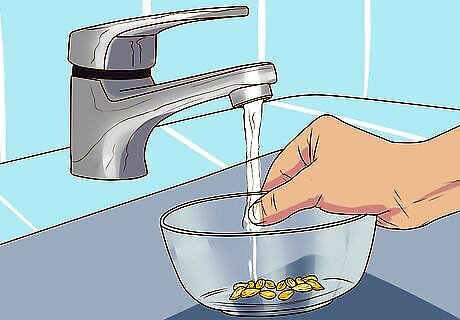
Select and clean the seeds. Look for plump, whole, healthy seeds that don’t have any spots, marks, dents, breaks, discoloration, or other blemishes or imperfections. Transfer the seeds to a bowl and fill it with clean water. Use a clean tea cloth to wipe the seeds and remove all traces of flesh and juice. Cleaning the seeds is also important for removing fungus and mold spores, and to prevent fruit flies. You can clean and germinate all the seeds in the orange, and then pick the biggest and healthiest sprouts to plant.

Soak the seeds. Fill a small bowl with clean room temperature water. Transfer the seeds to the water and let them soak for 24 hours. Many seeds have a better chance of sprouting if they're soaked first, because soaking softens the seed coating and kickstarts the germination. When the seeds have soaked for 24 hours, drain the water and place the seeds on a clean towel. Don’t soak the seeds for longer than this, or they may become waterlogged and not sprout.
Sprouting the Seeds
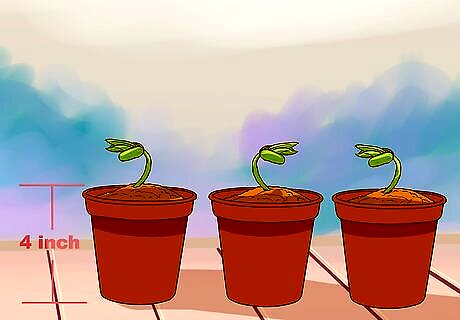
Transfer the seed to a prepared pot or into the ground. Get a 4-inch (10-cm) planting pot with drainage holes in the bottom or find a good spot in your yard to plant the seed. If planting directly into the ground, then dig a small hole and place the seed in the ground. If planting in a pot, fill the bottom with a thin layer of pebbles to increase drainage, and fill the pot the rest of the way with potting soil. Make a half-inch (1.3 cm) hole in the center of the soil with your finger. Place the seed into the hole and cover it with soil. After transplanting the seed to a pot, continue providing it with lots of direct sunlight every day.
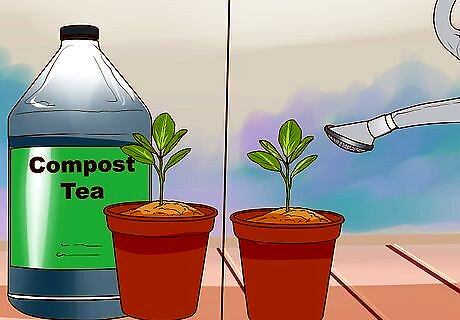
Fertilize and water the sprouts as they grow. Newly sprouted seedlings will benefit from a mild fertilizer, such as compost tea. Add enough of the compost tea to moisten the soil. Repeat every two weeks. Water the soil thoroughly once a week, or if the soil starts to become dry. If the soil dries out too often, the orange tree will not survive. As the seedling develops into a tree, it will start getting bigger and grow leaves.
Transplanting the Seedling
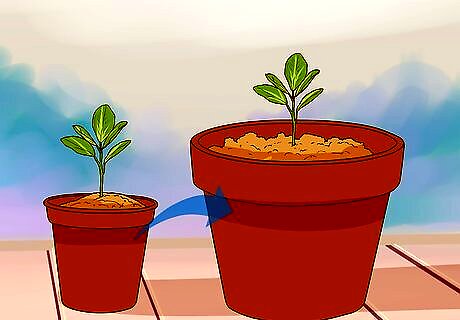
Prepare a larger pot when leaves appear. After several weeks, when the seedling has developed a few sets of leaves and grown in size, it will need to be transplanted to a larger pot. Use an 8” or 10” pot. Make sure it has drainage holes in the bottom, and add a layer of stones or pebbles first. Fill the pot most of the way with potting soil. Mix in a handful of peat moss and a handful of sand to provide the tree with well-draining and slightly acidic soil. Orange trees like a pH between 6 and 7.0. You can also look for citrus-specific potting soils at your garden center.

Plant the seedling in the larger pot. Make a hole in the center of the soil in the new pot that’s about 2 inches (5 cm) deep and 2 inches wide. First, put a layer of soil in the bottom of the pot you will be using. Then, squeeze or tap the pot that the seedling is currently in to loosen the soil. As you do so, slide the soil and roots out of the pot in one piece and transfer them into the new pot. After transferring, fill in the area around the root ball with new soil. Water the soil right away so that it’s moist.

Place the pot in a sunny location. Move the tree to a sunny location that gets plenty of direct light. Near a southern or south-eastern window is great, but a solarium or greenhouse is even better. In warm climates, you can move the potted tree outside in spring and summer, but place it somewhere that’s protected from strong winds.
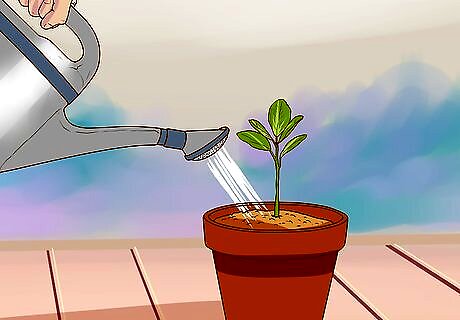
Provide plenty of water. Orange trees love regular watering. During the warm spring and summer months, water the plant deeply once a week. In areas where there's regular rainfall, water when necessary to make sure the soil stays moist. During the winter months, allow the top layer of soil to dry out partially before watering.
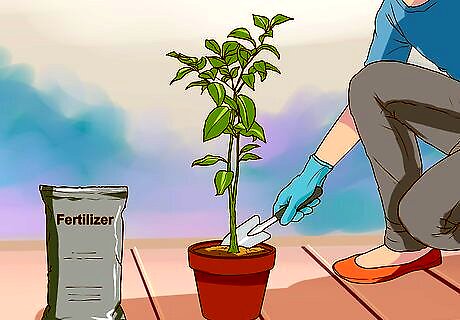
Fertilize the growing tree. Orange trees are heavy feeders and need lots of nutrients. Feed the tree with a balanced fertilizer, such as 6-6-6, twice a year. Feed the tree once in early spring and once in early fall. This is especially important during the first few years, before the tree starts bearing fruit. There are also citrus specific fertilizers that you may be able to find at a garden center.
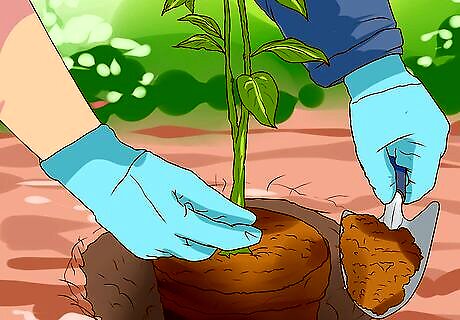
Transplant to larger pots or an outdoor location as the tree grows. When the tree is about a year old, transplant it to a 10- or 12-inch (25- or 30-cm) pot. After that, transplant the tree to a larger pot every March. Alternatively, if you live in an area that stays relatively warm all year round, you can transplant the tree to a sunny location outside. Orange trees will typically not survive if they're exposed to temperatures below 25 F (-4 C), so they can't be permanently transplanted outside in cooler areas. Fully grown orange trees are large, so if you live in a cooler climate, keep the tree in a solarium or greenhouse if possible.




















Comments
0 comment